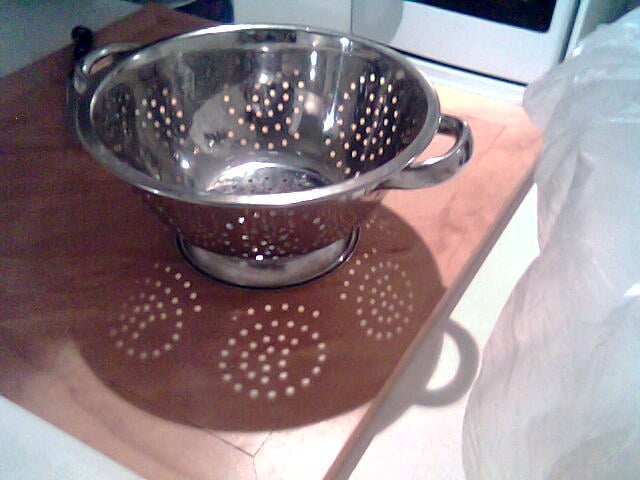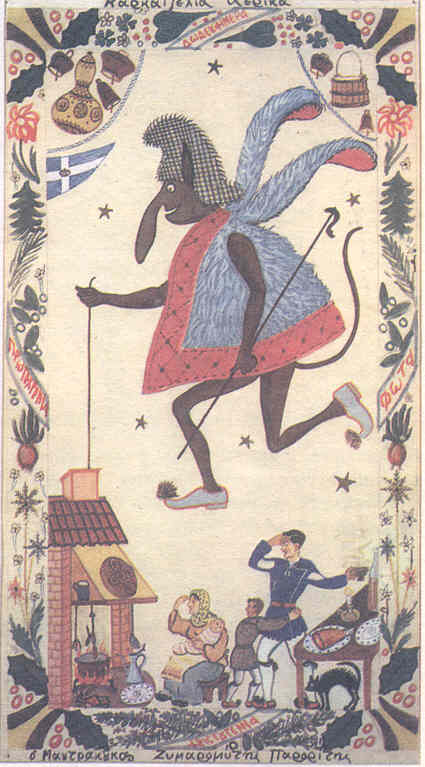Previously: Letta The Haunted Doll.
Type: AC (Agents of Chaos).
Period/location of origin: Subjects’ precise period of origin is unknown, although they are known to have gained a great deal of popularity in the Middle Ages. Subjects are prevalent in Southeast Europe, particularly in Greece — hence their frequent moniker of “Greek Christmas goblins,” in addition to their actual name of kallikantzaroi.

Appearance: Subjects, known in the singular as kallikantzaros (καλικάντζαρος) and in the plural as kallikantzaroi (καλικαντζαροι), are often described as small, dark, and covered in hair, sometimes with satyr-like characteristics such as goat-like legs and hooved feet. They may also have long, dark tails. Some artists’ depictions of them are more animalistic than others; as such, it is not known precisely how human they appear versus how animal-like.
All sources agree that they are… unpleasant to look at.
[Like what you read? Check out Dangerous Games To Play In The Dark, available from Chronicle Books now!]
Modus operandi: Subjects’ motive is quite simple: To cause mischief (ergo, their classification as Agents of Chaos). The reasoning behind their motive is also simple: They do it for fun.
Kallikantzaroi live primarily underground, spending their time sawing, chopping, or, according to some sources, chewing at the tree that holds up the Earth — not quite a tree of life or world tree, but similar — in the hopes that they will be able to bring down both the tree itself and the Earth with it. However, around Christmas Eve, they suddenly realize the gravity of what they are doing and abandon the tree, fearing that it will crush them it falls.
To prevent their own destruction, they accordingly rise to the surface of the Earth and proceed to wreak as much havoc as possible on the humans who live there. For the fortnight between Dec. 25 and the sixth of January — that is, from Christmas through Epiphany (the period sometimes referred to as the 12 Days Of Christmas, depending on whether one includes the dates that bookend the holidays) — they hide during the day, then emerge at night to perform various acts of mischief.
These acts may include, but are not limited to:
- Gaining entry to targets’ homes by coming down the chimney or sneaking in through the cracks in the walls;
- Stealing sweets;
- Spoiling milk or other foodstuffs;
- Scattering large quantities of flour throughout the home;
- Breaking household items or furniture;
- Despoiling flowers or plants;
- Muddying up the home;
- And otherwise causing general mess and mayhem.

After their time on the surface is up — either because they grow bored, or because they are banished by priests or other religious figures — they return again to the depths of the Earth. Upon their arrival back home, they discover that the tree has been fully restored and is once again whole. They set to sawing, chopping, or chewing the tree once more, and the cycle begins anew.
This sequence of events occurs every year. For all their chaotic energy, the Greek Christmas goblins are yet creatures of habit.
Containment: Subjects are not particularly bright, and may therefore be contained, neutralized, or otherwise staved off relatively easily in any of the following ways:
- Placing a colander on the doorstep of the home. Kallikantzaroi, like many other folkloric creatures, have something of a counting compulsion, and when presented with a colander, they will be seized by an overwhelming urge to count all the holes in it. However, they are unable to utter the number “three,” due to its status as a “holy” number; as such, they will be able to count only to two before needing to start over again. They will remain stuck in this pattern until the sun rises, at which point they will abandon the task — and the home — in order to seek refuge from the sun.
- Burning incense. Kallikantzaroi are sensitive to the smell.
- Burning something else that produces an unpleasant or strong aroma. Old shoes, for instance, or chamomile. These smells will also keep kallikantzaroi away.
- Marking the door of the home with a cross. Kallikantzaroi do not like religious iconography and will not be able to enter any homes with a cross on the door.
- Placing yarn or cotton string in the home’s garden. This strategy plays into the easily-distracted nature of the kallikantzaroi: Should they come across a quantity of yarn, string, or thread, they will feel compelled to pick it up and begin knitting. Provide enough yarn, and they will knit until the sun rises — when, similarly to the colander method, they will be required to abandon the task in order to get out of the sun, thus leaving the home undisturbed.
- Leaving food out as an offering. The kallikantzaroi may accept the food as a gift and leave satisfied instead of tearing up the home. Favorites include bread, meat, and sweets.
- Hanging a pig’s jaw in the chimney or on the door of the home. Sources do not specify the reasoning behind this particular strategy, but it likely either distracts kallikantzaroi attempting to enter a home, or else repels them due to its smell.
- Keeping a fire burning continuously in any and all fireplaces or woodburning stoves for the period between Christmas and Epiphany. Kallikantzaroi do not like fire, and will therefore avoid places with well-tended-to flames. Additionally, having a fire or fires burning continuously make it unsafe for a kallikantzaros to enter a home through its chimney; they are as susceptible to damage caused by burning flames as humans are. (Please note, however, that this containment method is not currently recommended, due to its dangers as a fire hazard.)
Additionally, children born during the period between Christmas and Epiphany may be at an increased risk of becoming a kallikantzaros (although the mechanism by which this transformation occurs is not generally specified). The methods for detecting and preventing this transformation are not particularly safe and therefore not recommended — but for thoroughness’ sake, they are as follows:
- To determine whether a child is at risk, place them in an unlit oven and ask whether they would prefer meat or bread.
- If they answer bread: They are safe; nothing is amiss.
- If they answer meat: They may be at risk.
- To protect a newborn from becoming a kallikantzaros, hold their feet near a lit candle. This will prevent their feet from sprouting claws or hooves. Alternatively, wrap them in garlic or straw.

The most effective containment method is called the Blessing of the Waters. This ritual is performed in the Greek Orthodox church on Epiphany as a means of sending subjects back where they belong. It consists of several actions:
- First, priests use sprigs of basil to sprinkle holy water on the homes of targets and potential targets.
- Publicly-accessible receptacles of holy water are also placed outside places of worship; townsfolk and villagers in affected towns may retrieve holy water for themselves from these receptacles and use them on their homes in a DIY fashion.
- And lastly, priests and townsfolk alike gather at local bodies of water, at which time a cross will be hurled into the water. Those wishing to participate will then dive into the water to search for and retrieve the cross. This portion of the ritual has been described by some sources as akin to a Polar Bear Plunge, albeit one with specific goals beyond simply endurance.
Additional notes: The period of time during which subjects are active is something of a liminal space; the 12 Days Of Christmas are, traditionally, a period that’s considered “unblessed” — that is, in the timeline of the Nativity, it’s between the birth and the baptism. This “unblessedness” is what allows subjects to roam freely during this time. The Epiphany marks the end of this period, after which subjects must return to their subterranean home.
Kallikantzaroi are sometimes described as not having particularly good vision; this may contribute to their degree of sensitivity regarding smells. It is perhaps also worth noting that they themselves are also frequently described as malodorous — but they may not be bothered by their own smell due to simply being accustomed to it.
Their primary diet consists of frogs, worms, and other creepy or crawly creatures. One would suspect that their fondness for sweets may be a result of otherwise being forced to consume such creatures, but they are often said to like eating these creatures — so a direct relationship between their regular diet and the sweets they like to steal during their 12 days aboveground cannot be definitively proven.
According to some sources, there are 18 specific kallikantzaroi that make up the group, each with their own name and personality traits. In this variation, they resemble the Yule Lads — Gryla’s children — of Icelandic lore although they operate in a slightly less organized fashion (that is, unlike the Yule Lads, they do not visit targets’ homes one per day or in a particular order; they simply go where they want, when they want). However, not all sources specify this particular detail, so it may not be definitively stated that there are or are not precisely 18 kallikantzaroi in existence.
Subjects are reportedly not officially recognized by the Greek Orthodox church, but belief in them is generally understood and accepted. As such, the Blessing of the Waters is not strictly for the banishment of subjects, but this auxiliary function is accepted as an offshoot of the ceremony.
Although kallikantzaroi are perhaps most closely associated with Greece, tales of their doings may also be seen in Bulgaria, Turkey, Serbia, Albania, Bosnia, and Cyprus. There may be regional variations on their appearance, modus operandi, and/or containment methods, however; should one find oneself dealing with kallikantzaroi or other entities similar to them, be sure to seek information and methods pertaining directly to that specific circumstance.
Recommendation: Subjects may be nuisances, but they are not particularly dangerous. Give them what they want and they’ll leave you alone… although even if they do cause a little mischief, it shouldn’t be too hard to put right again after they’re gone.
They only get 12 days out a year, after all, right?
Resources:
The Christmas Goblins of Greece Play Devious Tricks All the Way Till January at Atlas Obscura.
Kallikantzari: The Trolls of Greek Christmas at The Greek Vibe.
Kallikantzaroi at Daimonoligia.
Kalikantzaroi: The Greek Goblins That Run Wild At Christmas at Greek Reporter.
Epiphany Day: When Greeks Bless The Waters To Mark A New Start at The Greek Vibe.
Kalikantzaroi: What Are They at HelpPost. (In Greek.)
Who Hasn’t Heard Of Christmas Goblins? at EL.gr. (In Greek.)
***
Follow The Ghost In My Machine on Bluesky @GhostMachine13.bsky.social, Twitter @GhostMachine13, and Facebook @TheGhostInMyMachine. And for more games, don’t forget to check out Dangerous Games To Play In The Dark, available now from Chronicle Books!
[Photos via mandamonium/Flickr, available under a CC BY-ND 2.0 DEED Creative Commons license; public domain, Katolophyromai (available under a CC BY-SA 4.0 DEED Creative Commons license)/Wikimedia Commons]
Leave a Reply